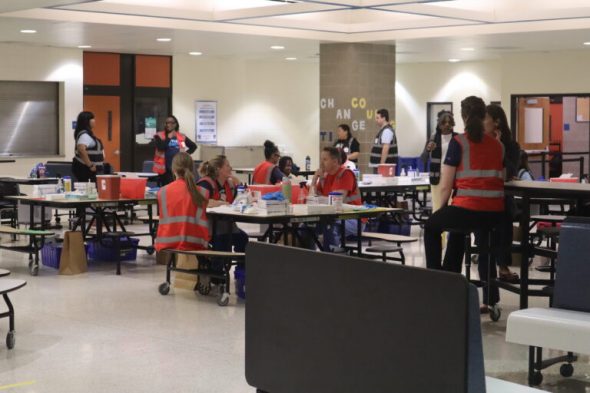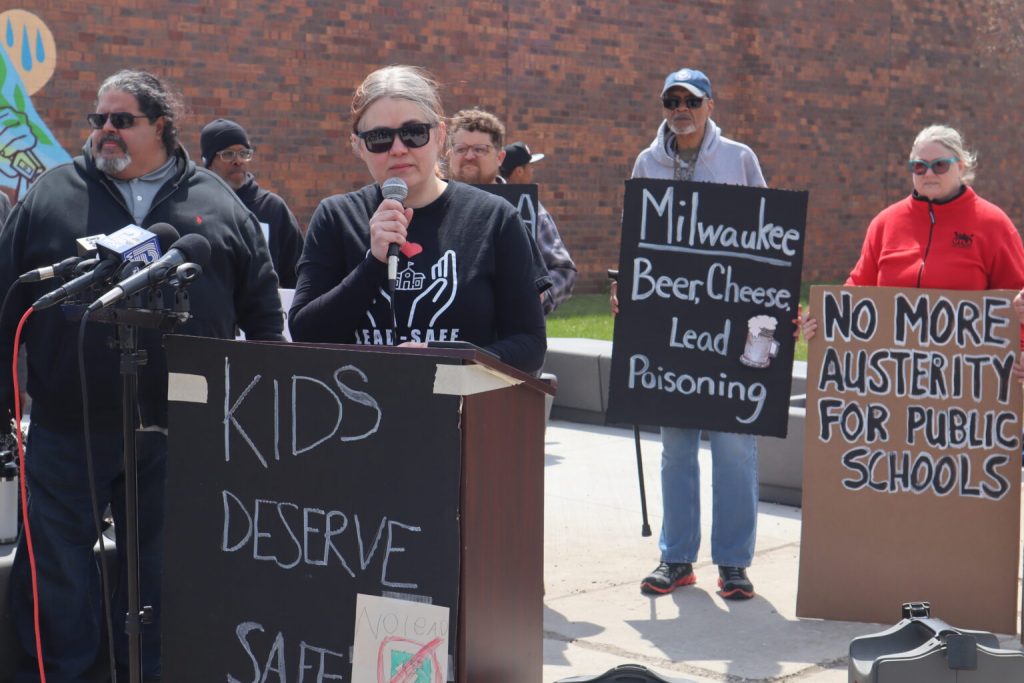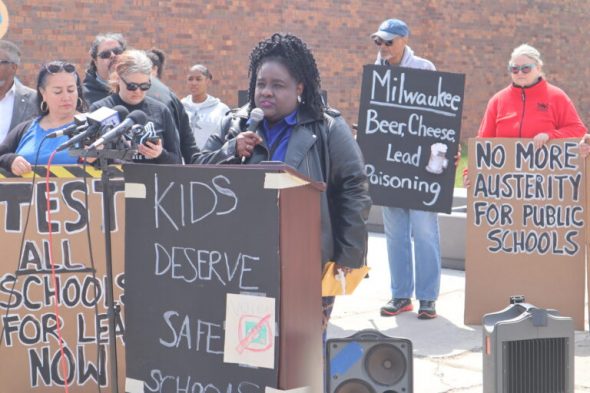Outside MPS Lead Clinic, Coalition Demands District, City Be Proactive, Not Reactive
Despite attention, only 22 kids were tested at event.
As a lead screening clinic was being set up inside Milwaukee’s North Division High School Wednesday, a coalition of parents, teachers and locals gathered outside to voice their frustrations about the response to lead contamination in Milwaukee Public School’s (MPS). The group had gathered to “demand that lead contamination in our schools, our city and our state, be urgently and effectively addressed in a manner consistent with health science data,” said Kristen Payne, a member of Lead Safe Schools MKE, during a press conference outside the high school.
The press conference brought together several groups including Lead Safe Schools MKE, Freshwater for Life Action Coalition, Get the Lead Out and Metcalfe Park Community Bridges. Inside North Division, the Milwaukee Health Department set up a clinic in the cafeteria and prepared to screen up to 300 children. Concern over lead in MPS buildings has grown since January, after a student was reportedly poisoned. Just under 400 MPS students have been tested and several schools temporarily closed due to lead hazards so far this year.

Melody McCurtis, deputy director and lead organizer of Metcalfe Park Community Bridges. (Photo by Isiah Holmes/Wisconsin Examiner)
“Testing our kids for lead poisoning is important, and it’s also not nearly enough,” Payne said. “Until the district, city and state work proactively to address root causes of lead exposure, these testing clinics will do little to prevent exposure of a harmful toxin.” Every year, more than 1,200 children in the city of Milwaukee test positive for lead poisoning, with an average age of three years old. With over 70,000 MPS students among the tens of thousands of children in the city, ensuring that enough children are getting tested can be challenging.
Katie Doss is the grandmother of one of those children who tested positive. “She was hospitalized,” said Doss, and received a blood transfusion. The experience led Doss to work with the Coalition on Lead Emergency (COLE) and city officials to help get as many children tested as possible. She eventually became a lead program coordinator. “Since then, I’ve got over 400 children tested,” said Doss.
Doss wasn’t alone. “I believe that my grandchildren have the right to go to school without the threat of exposure to lead,” said Maria Beltran, a local resident, grandmother and member of Freshwater for Life Action Coalition. “Lead exposure in children, like my entire family and myself — I have seven kids, seven grandchildren, and married — lead exposure in children can damage the brain and nervous system, cause developmental delays, learning challenges, behavioral issues, [and] hearing loss. Also in adults, lead exposure and lead poisoning can cause high blood pressure, kidney damage, brain damage, miscarriage, and infertility that I have experienced in my entire family as well.”
The group of parents and residents that joined Payne expressed their feeling that MPS and the Health Department have been more reactive than protective when it comes to addressing lead contamination. Some questioned why only elementary schools, and not middle and high schools, are the focus of current testing and remediation efforts. Others felt that they’d been left in the dark as to how lead poisoning affected their loved ones, or felt that school officials were sending out last-minute warnings to parents about lead hazards. Such notifications often came as emails, sent in the evening hours or near weekend days, parents at the press conference said.
Melody McCurtis, deputy director and lead organizer of Metcalfe Park Community Bridges, said that city officials are concerned with “growing the city without repairing the past harm that the current residents in this city is facing, especially in terms of lead.” McCurtis added, “This city is prioritizing policing in our schools, prioritizing more than half of our city budget going to the police, but not going to prevention of crises like the lead crisis. It is going to take more than the Milwaukee Public Schools, the Health Department and the city elected officials to come together to not just treat the issue, but to prevent it from happening.”

A lead screening clinic established in the cafeteria of Milwaukee’s North Division High School. (Photo by Isiah Holmes/Wisconsin Examiner)
Inside the high school’s cafeteria, Health Department Commissioner Micheal Totoraitis and Deputy Commissioner of Environmental Health Tyler Weber were helping oversee the final preparations for the screening clinic. They said lead dust and paint are a target and the city’s youngest children are being prioritized for lead testing. “That’s not to minimize that there are other hazards here at the schools and potentially in the homes,” said Totoraitis.
Although older children and adults will need to be included in testing eventually, it’s unclear how long that might take. The city is still re-grouping after plans to send specialized lead teams from the Centers for Disease Control and Prevention (CDC) to Milwaukee were cancelled by the Trump Administration. The teams would have helped with blood screening analysis to detect trends and gather more information. Totoraitis said that the health department has monitored citywide data for screenings, and has not noticed any new trends. Milwaukee is also working with partners in other states including Ohio and Michigan. More parents have been taking their children to pediatricians to get tested, which is encouraging, Totoratis said. “That is the best way for parents to know if their child has been poisoned,” he said.
MPS assumes that lead paint exists in any building built before 1978, and the school district has 54 schools built before 1950. Addressing the full scale of the problem will take creativity, dedicated effort and time, health officials say. Weber said that although it’s good that positive tests since January have been relatively low, many more children still need to be evaluated.
Doss told Wisconsin Examiner that it can be difficult to convince parents to get their children tested. “It’s extremely challenging,” said Doss. “There are a lot of parents that’s lost hope and faith in the community as far as getting the children tested. They want to know what’s going to happen on the reaction. If they get their child tested, will they be actually judged if the child comes back with lead and they don’t know where the lead is coming from?”
Doss said some parents fear that a positive lead test will lead to their homes being visited by authorities, or even that their children could be taken away. “So that’s why it’s very important to let the parents know that it’s nothing that they did. It’s in our environment, it’s in our water, it’s in the paint…The only way that you can help your child is to get your child tested to know if your child has it. And you need to get your child tested once a year. It’s very important.”
The scale of the problem, and a lack of capacity within the health department, creates stubborn obstacles. “And our old housing stock, the red-lining that’s happened over time, the disinvestment in communities, and so it’s a lot for a single department to get to the point where we get ahead of this,” Weber said. “‘Cause it is devastating to have to see every day the results that come in from different children, and respond to those.”
Weber added that ideally lead levels in soil, homes, water and human bodies would be zero. “We’re an old city with a lot of deeply rooted challenges, and there’s a lot of work that we have to do collectively.”
Lead screening clinic held in Milwaukee high school was originally published by the Wisconsin Examiner.

Existing members must be signed in to see the interactive map. Sign in.
If you think stories like this are important, become a member of Urban Milwaukee and help support real, independent journalism. Plus you get some cool added benefits.






















